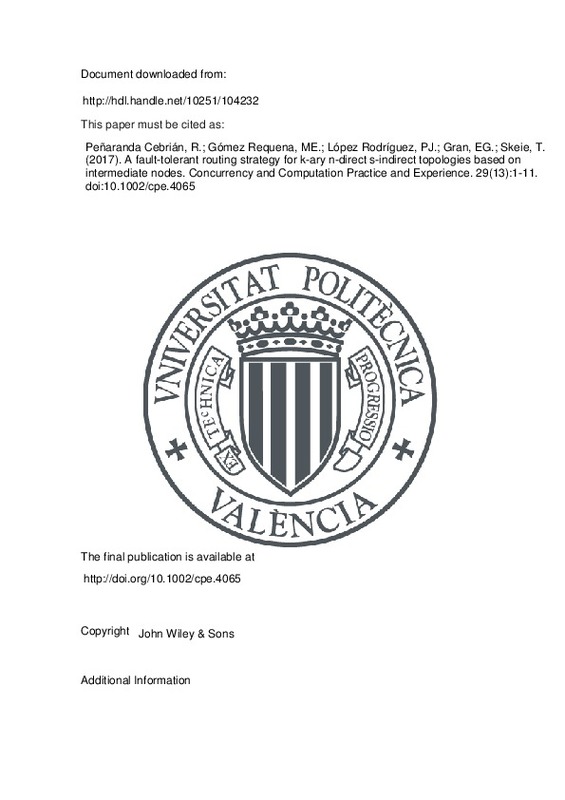JavaScript is disabled for your browser. Some features of this site may not work without it.
Buscar en RiuNet
Listar
Mi cuenta
Estadísticas
Ayuda RiuNet
Admin. UPV
A fault-tolerant routing strategy for k-ary n-direct s-indirect topologies based on intermediate nodes
Mostrar el registro sencillo del ítem
Ficheros en el ítem
| dc.contributor.author | Peñaranda Cebrián, Roberto
|
es_ES |
| dc.contributor.author | Gómez Requena, María Engracia
|
es_ES |
| dc.contributor.author | López Rodríguez, Pedro Juan
|
es_ES |
| dc.contributor.author | Gran, Ernst Gunnar
|
es_ES |
| dc.contributor.author | Skeie, Tor
|
es_ES |
| dc.date.accessioned | 2018-06-17T04:24:59Z | |
| dc.date.available | 2018-06-17T04:24:59Z | |
| dc.date.issued | 2017 | es_ES |
| dc.identifier.issn | 1532-0626 | es_ES |
| dc.identifier.uri | http://hdl.handle.net/10251/104232 | |
| dc.description.abstract | [EN] Exascale computing systems are being built with thousands of nodes. The high number of components of these systems significantly increases the probability of failure. A key component for them is the interconnection network. If failures occur in the interconnection network, they may isolate a large fraction of the machine. For this reason, an efficient fault-tolerant mechanism is needed to keep the system interconnected, even in the presence of faults. A recently proposed topology for these large systems is the hybrid k-ary n-direct s-indirect family that provides optimal performance and connectivity at a reduced hardware cost. This paper presents a fault-tolerant routing methodology for the k-ary n-direct s-indirect topology that degrades performance gracefully in presence of faults and tolerates a large number of faults without disabling any healthy computing node. In order to tolerate network failures, the methodology uses a simple mechanism. For any source-destination pair, if necessary, packets are forwarded to the destination node through a set of intermediate nodes (without being ejected from the network) with the aim of circumventing faults. The evaluation results shows that the proposed methodology tolerates a large number of faults. For instance, it is able to tolerate more than 99.5% of fault combinations when there are 10 faults in a 3-D network with 1000 nodes using only 1 intermediate node and more than 99.98% if 2 intermediate nodes are used. Furthermore, the methodology offers a gracious performance degradation. As an example, performance degrades only by 1% for a 2-D network with 1024 nodes and 1% faulty links. | es_ES |
| dc.description.sponsorship | This work was supported by the Spanish Ministerio de Economía y Competitividad (MINECO), by FEDER funds under Grant TIN2015-66972-C5-1-R, by Programa de Ayudas de Investigación y Desarrollo (PAID) from Universitat Politècnica de alència and by the financial support of the FP7 HiPEAC Network of Excellence under grant agreement 287759 | |
| dc.language | Inglés | es_ES |
| dc.publisher | John Wiley & Sons | es_ES |
| dc.relation.ispartof | Concurrency and Computation Practice and Experience | es_ES |
| dc.rights | Reserva de todos los derechos | es_ES |
| dc.subject | Exascale computing | es_ES |
| dc.subject | Fault-tolerant routing | es_ES |
| dc.subject | Hybrid topology | es_ES |
| dc.subject | KNS topology | es_ES |
| dc.subject.classification | ARQUITECTURA Y TECNOLOGIA DE COMPUTADORES | es_ES |
| dc.title | A fault-tolerant routing strategy for k-ary n-direct s-indirect topologies based on intermediate nodes | es_ES |
| dc.type | Artículo | es_ES |
| dc.identifier.doi | 10.1002/cpe.4065 | es_ES |
| dc.relation.projectID | info:eu-repo/grantAgreement/MINECO//TIN2015-66972-C5-1-R/ES/TECNICAS PARA LA MEJORA DE LAS PRESTACIONES, COSTE Y CONSUMO DE ENERGIA DE LOS SERVIDORES/ | es_ES |
| dc.relation.projectID | info:eu-repo/grantAgreement/EC/FP7/287759/EU/High Performance and Embedded Architecture and Compilation/ | es_ES |
| dc.rights.accessRights | Abierto | es_ES |
| dc.date.embargoEndDate | 2018-07-11 | es_ES |
| dc.contributor.affiliation | Universitat Politècnica de València. Departamento de Informática de Sistemas y Computadores - Departament d'Informàtica de Sistemes i Computadors | es_ES |
| dc.description.bibliographicCitation | Peñaranda Cebrián, R.; Gómez Requena, ME.; López Rodríguez, PJ.; Gran, EG.; Skeie, T. (2017). A fault-tolerant routing strategy for k-ary n-direct s-indirect topologies based on intermediate nodes. Concurrency and Computation Practice and Experience. 29(13):1-11. https://doi.org/10.1002/cpe.4065 | es_ES |
| dc.description.accrualMethod | S | es_ES |
| dc.relation.publisherversion | http://doi.org/10.1002/cpe.4065 | es_ES |
| dc.description.upvformatpinicio | 1 | es_ES |
| dc.description.upvformatpfin | 11 | es_ES |
| dc.type.version | info:eu-repo/semantics/publishedVersion | es_ES |
| dc.description.volume | 29 | es_ES |
| dc.description.issue | 13 | es_ES |
| dc.relation.pasarela | S\338133 | es_ES |
| dc.contributor.funder | Ministerio de Economía, Industria y Competitividad | es_ES |
| dc.contributor.funder | European Commission | |
| dc.contributor.funder | Universitat Politècnica de València |







![[Cerrado]](/themes/UPV/images/candado.png)

